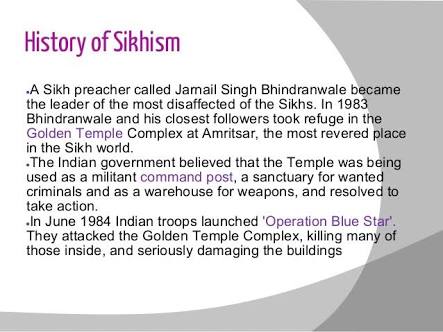Sikh world history
.jpg)
Sikh world history
Sources of Sikhism
Sikhism was conceived in the Punjab zone of South Asia, which now falls into the present day conditions of India and Pakistan. The primary religions of the region at the time were Hinduism and Islam.
The Sikh confidence started around 1500 CE, when Master Nanak started instructing a confidence that was very particular from Hinduism and Islam.
Nine Masters took after Nanak and built up the Sikh confidence and group throughout the following hundreds of years.
Militarisation of the Sikhs
Sikhism was entrenched when of Master Arjan, the fifth Master.
Master Arjan finished the foundation of Amritsar as the capital of the Sikh world, and accumulated the primary approved book of Sikh sacred text, the Adi Granth.
Nonetheless, amid Arjan's chance Sikhism was viewed as a danger by the state and Master Arjan was in the end executed for his confidence in 1606.
The 6th Master, Hargobind, began to mobilize the group with the goal that they would have the capacity to oppose any persecution. The Sikhs battled various fights to save their confidence.
The Sikhs at that point lived in relative peace with the political rulers until the season of the Moghal Sovereign, Aurangzeb, who utilized power to influence his subjects to acknowledge Islam.
Aurangzeb had the ninth Master, Tegh Bahadur, captured and executed in 1675.
The Khalsa
The tenth Master, Gobind Singh, reproduced the Sikhs as a military gathering of men and ladies called the Khalsa in 1699, with the goal that the Sikhs ought to for ever have the capacity to protect their confidence.
Gobind Singh built up the Sikh ritual of start (called khandey di pahul) and the 5 Ks which give Sikhs their special appearance.
Gobind Singh was the last human Master. Sikhs now regard their sacred writings as their Master.
After the Masters
The principal military pioneer of the Sikhs to take after the Masters was Banda Singh Bahadur.
He drove an effective battle against the Moghals until the point that he was caught and executed in 1716.
Amidst the century the Sikhs ascended once more, and throughout the following 50 years assumed control increasingly an area.
In 1799 Ranjit Singh caught Lahore, and in 1801 built up the Punjab as an autonomous state, with himself as Maharaja.
He demonstrated a proficient leader of a state in which Sikhs were still in a minority.
Despite the fact that a dedicated Sikh, he participated in religious acts with Muslims and Hindus too.
Vanquished by the English
After Ranjit Singh kicked the bucket in 1839 the Sikh state disintegrated, harmed by horrible inner fights for the administration.
In 1845-6 troops of the English Realm crushed the Sikh armed forces, and assumed control a much Sikh area.
The Sikhs revolted again in 1849, and were vanquished by the English, this time convincingly.
The Sikhs and the English Raj
After this last fight, the Sikhs and the English found they had much in like manner and fabricated a decent relationship. The convention started of Sikhs presenting with awesome refinement in the English Armed force.
The Sikhs got on well with the English halfway in light of the fact that they came to consider themselves less as subjects of the Raj than as accomplices of the English.
The English helped themselves get a positive religious turn when they took control of the Sikh religious foundation by putting their own particular decisions responsible for the Gurdwaras.
Great relations amongst Sikhs and English arrived at an end in 1919 with the Amritsar slaughter
Nice
Thanks
Welcm